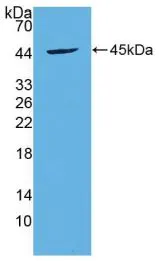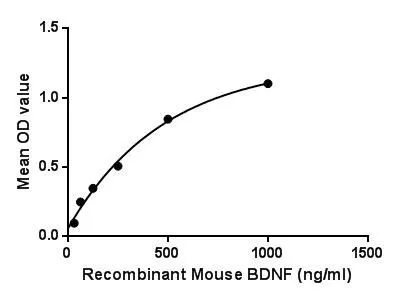
WB analysis of GTX00322-pro Mouse BDNF protein.
Mouse BDNF protein, His tag
GTX00322-PRO
ApplicationsFunctional Assay
Product group Proteins / Signaling Molecules
Protein IDP21237
Overview
- SupplierGeneTex
- Product NameMouse BDNF protein, His tag
- Delivery Days Customer9
- Application Supplier NoteBrain-derived neurotrophic factor, also known as BDNF, is a member of the neurotrophin family of growth factors, which are related to the canonical Nerve Growth Factor. BDNF acts on certain neurons of the central nervous system and the peripheral nervous system, helping to support the survival of existing neurons, and encourage the growth and differentiation of new neurons and synapses. Besides, Amyloid Precursor Protein (APP) has been identified as an interactor of BDNF, thus a binding ELISA assay was conducted to detect the interaction of recombinant mouse BDNF and recombinant mouse APP. Briefly, BDNF were diluted serially in PBS with 0.01% BSA (pH 7.4). Duplicate samples of 100 microl were then transferred to APP-coated microtiter wells and incubated for 2h at 37C. Wells were washed with PBST and incubated for 1h with anti-BDNF pAb, then aspirated and washed 3 times. After incubation with HRP labelled secondary antibody, wells were aspirated and washed 3 times. With the addition of substrate solution, wells were incubated 15-25 minutes at 37C. Finally, add 50 microl stop solution to the wells and read at 450nm immediately. The binding activity of of BDNF and APP was in a dose dependent manner.
- ApplicationsFunctional Assay
- CertificationResearch Use Only
- ConjugateUnconjugated
- Protein IDP21237
- Protein NameNeurotrophic factor BDNF precursor form
- Scientific DescriptionThe protein encoded by this gene is a member of the nerve growth factor family. It is involved in the growth, differentiation and survival of specific types of developing neurons both in the central nervous system (CNS) and the peripheral nervous system. It is also involved in regulating synaptic plasticity in the CNS. Expression of a similar gene in human is reduced in both Alzheimers and Huntington disease patients. Alternative splicing results in multiple transcript variants encoding different isoforms that may undergo similar processing to generate mature protein. [provided by RefSeq, Oct 2015]
- Storage Instruction-20°C or -80°C,2°C to 8°C
- UNSPSC12352202



